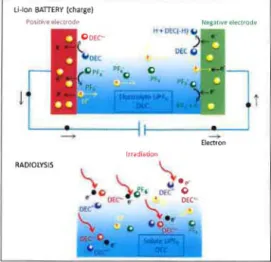HAL Id: cea-02339028
https://hal-cea.archives-ouvertes.fr/cea-02339028
Submitted on 30 Oct 2019HAL is a multi-disciplinary open access archive for the deposit and dissemination of sci-entific research documents, whether they are pub-lished or not. The documents may come from teaching and research institutions in France or abroad, or from public or private research centers.
L’archive ouverte pluridisciplinaire HAL, est destinée au dépôt et à la diffusion de documents scientifiques de niveau recherche, publiés ou non, émanant des établissements d’enseignement et de recherche français ou étrangers, des laboratoires publics ou privés.
Accelerated ageing of electrolytes in Lithium-ion
batteries: the point of view of a radiation chemist
Sophie Le Caër
To cite this version:
Sophie Le Caër. Accelerated ageing of electrolytes in Lithium-ion batteries: the point of view of a radiation chemist. Conférence de Physique-Chimie (CPC16), Oct 2016, Nancy, France. �cea-02339028�
CPC16 - Conférence de Physique-Chimie - Physical Chemistty Conference / October 17-20,2016. Nancy, France
Accelerated ageing of electrolytes in Lithium-ion batteries: the point of
view of a radiation chemist
Sophie Le Caër
LIONS, NIMBE UMR 3685, CEA, CNRS, Université Paris Saclay, Bât. 546, F-91191
Gif-sur-Yvette Cedex, France. email: sophie.le-caer@ceafr
Since the early nineties, the rechargeable Li-ion battery (LIB) technology has dominated the electronic market. These batteries have become essential components in portable electronic applications. Since then, ageing pro cesses are a growing global concern, essentially for their applications in electric and hybrid vehic1es.
Ageing phenomena occurring in diethylcarbonate (DEC), DEC/LiPF6 propylene carbonate (PC) and PC/LiPF6 solutions, selected as model systems, have been studied using gamma-and pulse- radiolysis as a tool to generate similar species as the ones occurring in e1ectro1ysis of Li-ion batteries and to mimic the processes (Fig. 1) [1-3]. We prove that similar results were obtained in the ageing of an electrochemical cell filled with the same model solution [2]. This highlights the interest of the radiolysis approach in the field of ageing of electrolytes. Radiolysis has indeed the following major advantages: i) ageing processes are strong1y accelerated (minutes/hours as compared to weeks and months in conventional battery studies); ii) time-resolved experiments are possible, enabling to study the system on multiple temporal scales (from picoseconds to minutes and days) [2]. This allows measuring rate constants, and writing very detailed reaction mechanisms; iii) the possibility to study the reactivity of each solvent without/with the salt (of course studies without the salt has no sense in the battery field!), leading to a very accurate understanding of the behavior of the system; iv) the possibility to perform a quick screening of many electrolytes, to identify rapidly the most promising ones. All these points will be discussed.
Li-Ion BATTERY (charge)
PositiveelE!c[tOde
Irrildiatîon RAorOlYSIS
~
)
..
. 0 .5" DEC' 0 • OK"" If' * OEe 01:''''-;' ReferencesFig. 1. Scheme comparing primary electron
transfers at the electrodes in the electrolytic charge/ageing processes of a Li-ion battery
(with molar DEC/ LiPF6 solution as a model
electrolyte) (top), and after ionization in the bulk in the radiolytic process with the same medium (bottom).
[1] D. Ortiz, V. Steinmetz, D. Durand, S. Legand, V. Dauvois, P. Maître, S. Le Caër, Nature Comm., 6, doi:10.l038/ncomms7950 (2015).
[2] D. Ortiz, 1. Jimenez Gordon, J.P. Baltaze, O. Hernandez-Alba, S. Legand, V. Dauvois, G. Si Larbi, U. Schmidhammer, J.-L. Marignier, J.-F. Martin, J. Belloni, M. Mostafavi, S. Le Caër, ChemSusChem, 8, 3605 (2015).
[3] S. Le Caër, D. Ortiz, J.-L. Marignier, U. Schmidhammer, J. Belloni, M. Mostafavi, J. Phys. Chem. Lett., 7, 186 (2016)
